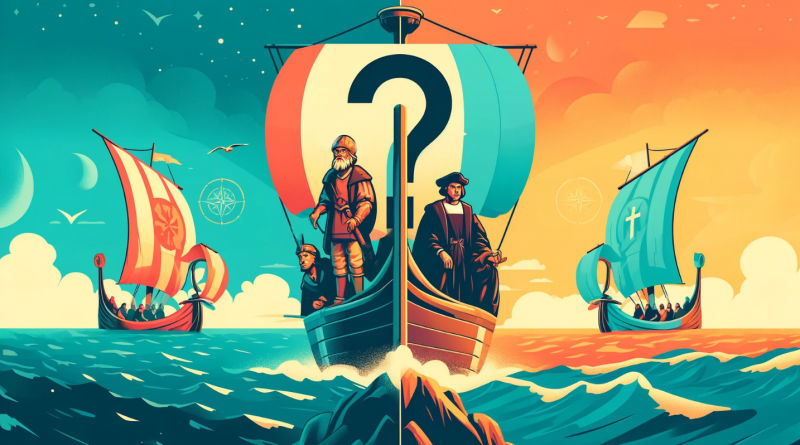Was Columbus the first European to reach America?
A blood type (also called a blood group) is a classification of blood-based on the presence or absence of inherited antigenic substances on the surface of red blood cells (RBCs). These antigens may be proteins, carbohydrates, glycoproteins, or glycolipids, depending on the blood group system. Some of these antigens are also present on the surface of other types of cells of various tissues. Several red blood cell surface antigens can stem from one allele (or very closely linked genes) and collectively form a blood group system. Blood types are inherited and represent contributions from both parents. A total of 32 human blood group systems are now recognised by the International Society of Blood Transfusion (ISBT). The two most important ones are ABO and the RhD antigen; they determine someone’s blood type (A, B, AB and O, with + and – denoting RhD status) – so what has this to to with the first European to reach America?
Many pregnant women carry a fetus with a blood type different from their own, and the mother can form antibodies against fetal RBCs. Sometimes these maternal antibodies are IgG, a small immunoglobulin, which can cross the placenta and cause haemolysis of fetal RBCs, leading to haemolytic disease of the newborn called erythroblastosis fetalis; an illness of low fetal blood counts that ranges from mild to severe. Sometimes this is lethal for the fetus; in these cases, it is called hydrops fetalis.
One of the Greatest Mysteries in Anthropology is how the A Rh neg blood groups originated in North America.
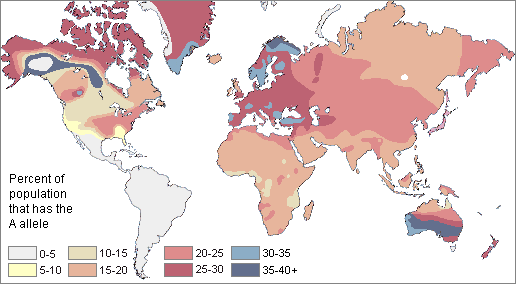
Blood groups are an excellent method to detect population migration in conjunction with modern DNA Haplogroups, as the former has been identified for over 100 years, unlike the contemporary techniques.
An individual either has or does not have the ‘Rhesus factor’ on the surface of their red blood cells. This term strictly refers only to the most immunogenic D antigen of the Rh blood group system or the Rh- blood group system. Rh-positive usually indicates the status (Rh+ does have the D antigen) or Rh negative (Rh- does not have the D antigen) suffix to the ABO blood type.
Our History books tell us…
According to the New World migration model, a migration of humans from Eurasia to the Americas took place via Beringia, a land bridge that connected the two continents across what is now the Bering Strait. However, the most recent point at which this migration could have taken place, where the first Americans set foot on Alaska, is 40,000 – 12,000 years ago, a hotly disputed topic.
Traditional distribution of ‘Walking’ humans in time
The early ‘stone age’ Paleo-Indians spread throughout the Americas, diversifying into many hundreds of culturally distinct nations and tribes. According to the oral histories of many of the indigenous peoples of the Americas, they have been living there since their genesis, described by a wide range of traditional creation accounts.
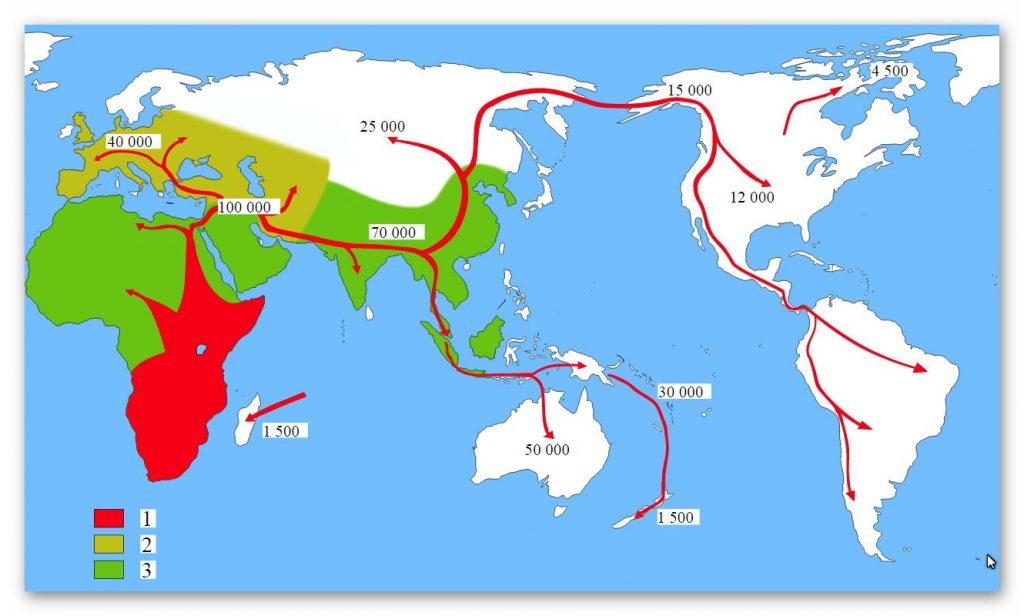
While some indigenous peoples of the Americas were historically hunter-gatherers, many practised aquaculture and agriculture. The impact of their agricultural endowment to the world is a testament to their time and work in reshaping and cultivating the flora indigenous to the Americas. Some societies depended heavily on agriculture, while others practised a mix of farming, hunting, and gathering. In some regions, the indigenous peoples created monumental architecture, large-scale organised cities, chiefdoms, states, and empires.
Indigenous Americans still populate many parts of the Americas; some countries have sizeable populations, especially Bolivia, Peru, Mexico, Guatemala, Colombia, and Ecuador. At least a thousand different indigenous languages are spoken in the Americas. Some, such as Quechua languages, Aymara, Guaraní, Mayan languages, and Nahuatl, count their speakers in millions. Many also maintain indigenous cultural practices to varying degrees, including religion, social organisation and subsistence practices. Nevertheless, some indigenous peoples still lived in relative isolation from Western society, and a few are still unconnected peoples.
So, according to wiki:
About 40,000 years ago, Homo Sapiens walked across the land bridge of Alaska and entered America, finally going south to they reached South America all sharing the same blood type ‘O’, but then a second wave came across in 12,000 BP (Before present) and brought the Blood type A, B and AB with them and settled only in North America.
But there is a massive problem with this theory – apart from who in their right mind would walk across a footbridge for over a thousand years to a cold and inhospitable place (Alaska)?
The Na-Dené, Inuit and Indigenous Alaskan populations exhibit haplogroup Q (Y-DNA); however, they are distinct from other indigenous Amerindians with various mtDNA and atDNA mutations. This suggests that the peoples who first settled the northern extremes of North America and Greenland derived from later migrant populations than those who penetrated further south in the Americas. Linguists and biologists have reached a similar conclusion based on analysis of Amerindian language groups and ABO blood group system distributions.
On the East Coast of Asia (at the start of the footbridge), there is less than 4% Rh Neg blood, 90% of the Blood is ‘O’ type Rh-positive – 6% A,B or AB Rh-positive. So, if travellers who took the ‘land bridge across’ their descendants disappeared into extinction of never leave a trace of interbreeding with the local peoples, even though they walked this pathway for thousands of years – not one stopped to settle or cohabited with the local population.
However, the Haplogroup Q (Y-DNA) shows apparent migration from America to Asia and not vice-versa.
Moreover, the indigenous American Blackfoot Indians of North America are 82% A blood group RH Negative- the other 18% are probably an example of interbreeding since modern Europeans conquered them and their footprint stretches from the lakes of the east coast but falls short of the American West Coast or Alaska.
So, where did the ‘indigenous’ people come from?
If we look at a map of the northern hemisphere, we will see a high frequency of the Rh neg bloodline is in Spain, Ireland, Scotland, Faroe Islands, Iceland, Greenland and Eastern Canada moving West down the East Coast of North America to Central America. This is because in 10 000 BCE, the sea levels were much lower and The Northern Atlantic looked a lot different than today, as the Sea Levels were 160m Lower and the landmasses such as Faroe, Iceland and Greenland were much more extensive than the present, allowing easy passage across the Atlantic to America, for any society who had the possession of sea boats.
There is substantial evidence that reed boats were constructed on the shorelines of the Caspian Sea since about 40,000 BP, which are depicted on the caves that would have overlooked the Post Glacial Flooded waters – which is nowadays about a mile from the present Caspian Sea shoreline. These types of reed boats would have achieved sea travel as shown in the 1970s by Thor Heyerdahl (October 6, 1914 – April 18, 2002) was a Norwegian ethnographer and adventurer with a background in biology zoology, botany, and geography.
He became notable for his Kon-Tiki expedition in 1947, in which he sailed 8,000 km (5,000 mi) across the Pacific Ocean in a hand-built raft from South America to the Tuamotu Islands. The expedition was designed to demonstrate that ancient people could have made long sea voyages, creating contacts between apparently separate cultures. This was linked to a diffusion model of cultural development. Heyerdahl subsequently made other voyages designed to demonstrate the possibility of communication between widely separated ancient peoples.

In 1969 and 1970, Heyerdahl built two boats from papyrus and attempted to cross the Atlantic Ocean from Morocco in Africa. Based on drawings and models from ancient Egypt, the first boat, named Ra (after the Egyptian Sun god), was constructed by boat builders from Lake Chad using papyrus reed obtained from Lake Tana in Ethiopia and launched into the Atlantic Ocean from the coast of Morocco. The Ra crew included Thor Heyerdahl (Norway), Norman Baker (USA), Carlo Mauri (Italy), Yuri Senkevich (USSR), Santiago Genoves (Mexico), Georges Sourial (Egypt) and Abdullah Djibrine (Chad).
Only Heyerdahl and Baker had sailing and navigation experiences. After several weeks, Ra took on water after its crew made modifications to the vessel that caused it to sag and break apart after sailing more than 4000 miles. The crew was forced to abandon Ra some hundred miles before Caribbean islands and was saved by a yacht.
The following year, 1970, another similar vessel, Ra II, was built of totara by Demetrio, Juan and Jose Limachi from Lake Titicaca in Bolivia and likewise set sail across the Atlantic from Morocco, this time with great success.
The voyage around the northern islands is simple but is made difficult due to extensive cloud cover. However, with the use of a device called a Sunstone, this difficulty can easily be overcome. A Sunstone is a device that allows navigators to follow the sun (indicating the direction of the sun) when it is daytime but cloudy. This device was known to be used as far back as the Viking societies, and as it was a ‘natural’ discovery, there is no reason that the use of the stone could not go further back in history.
So who were the first Europeans to find America?
It was formerly thought by palaeontologists that Neanderthal morphed into Cro-Magnon and that Cro-Magnon was the progenitor of human beings as we know them today. However, aside from the problems of the Eve Hypothesis, there are severe problems with the assumptions about when modern human types appeared on Earth. Even if we take the evolving scientific view of the present day, we find that Cro-Magnon man was something altogether different from other anatomically modern humans.
Over and over again, we read in scientific studies that Cro-Magnon man was just an “anatomically modern human.” The experts will say: “The Cro-Magnons lived in Europe between 35,000 and 10,000 years ago. They are virtually identical to modern man, tall and muscular and slightly more robust than most modern humans.”
Notice how they slip in that “slightly more robust” bit.
The fact is, the Cro-Magnon man was, compared to the other ‘anatomically modern humans’ around him, practically a superman. They were skilled hunters, toolmakers and artists famous for the cave art at Lascaux, Chauvet, and Altamira. According to anthropologists, “they had a high cranium, a broad and upright face, and cranial capacity – about the same as modern humans (can we say larger?), but less than that of Neanderthals. The males were as tall as 6 feet.”
They appeared in Europe in the upper Pleistocene about 40,000 years ago, and “their geographic origin is still unknown.” However, the DNA and colouring of Neanderthals indicate that they were Red Haired and Blue-eyed, unlike their Homo Sapien Cousins, who was dark-haired and brown-eyed.
Their skeletal remains show a “few small differences from modern humans.” But, of course, the “out of Africa” theory advocates suggest that Cro-Magnon came from Sub Saharan Africa and a temperate climate and that “they would eventually adapt to all extremes of heat and cold.” In this way, the “slight differences” between Cro-Magnon and other forms of anatomically modern humans can be explained away as an adaptation to the cold.
Moreover, Cro-Magnon’s have been found with Rh-Negative Blood (Cavalli-Sforza, L. Luca; Menozzi, Paolo; Alberto, Piazza (1994). The History and Geography of Human Genes)
A skeleton estimated as being 10,000 years old was found in the ‘tomb of Palli Aike’ in Tierra del Fuego in 1969-70 and has been identified as Cro-Magnon, which indicates that this race also spread to South America. It is now believed that Neanderthal man as the proto-European, and Cro-Magnon (a hybrid mutation) a later arrival, probably from the West. It is also thought that Cro-Magnons has many similarities to the North American Indians, being tall, muscular, athletic and agile.
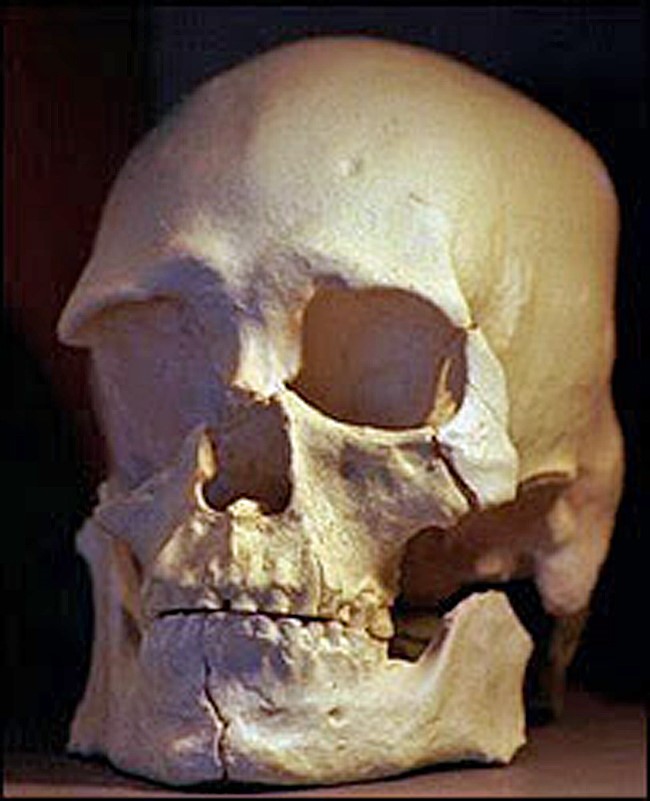
Dr James C. Chatters, a University of Washington’s specialist in human osteology, while investigating what was initially thought to be a modern homicide, found himself analysing the bones of a 9,000-year-old skeleton. Upon examination, the 5 feet 9 inches tall specimen had characteristics that are similar to those of Europeans” (Chatters, 2000). According to Chatters, the skull is dolichocranic (long-headed) rather than brachycranic (round-headed) and exhibits “fairly prominent brow ridges.” Now known as Kennewick Man, this skeleton possesses many of the characteristics of our typical Atlantean Cro-Magnons.
Poverty Point culture 8000 – 7000 BP is not well understood in terms of social organisation; it was involved in the transportation of non-local raw materials (for example, shell, stone, and copper) from throughout the eastern United States into the lower Mississippi River Valley to selected sites where the materials were worked into finished products and then traded. While specific information on Poverty Point subsistence, trade mechanisms, and other cultural aspects is still speculative, the sites, nevertheless, exhibit distinctive material culture, such as baked clay objects, magnetite plummets, steatite bowls, red jasper lapidary work, fibre-tempered pottery, and microlithic stone tools – which is a clear indication of European Cro-Magnon influence.
Dr Dennis Stanford of the Smithsonian Museum of Natural History in Washington states: “We now know that human beings learned to sail 50,000 years before the present. Humanity settled in Australia then, and any land bridge did not link it to Asia. It could only have been reached by boat. We had mastered sailing tens of thousands of years before America was colonised, so we should not be surprised by the idea that people took boat trips across the Atlantic 18,000 years ago” (Stanford & Bradley, 2004)
Dr Tom D. Dillehay (1999) of the University of Kentucky writes: “It is likely that people arrived in the Southern Hemisphere no later than 15,000 to 14,000 years ago.” One such site has been excavated at Monte Verde, Chile, 500 miles south of Santiago. First, evidence was gathered and carefully analysed over the last two decades by a team of American and Chilean archaeologists led by Dillehay. Then, early in 2006, a group of archaeologists, including several of Monte Verde’s most rigorous critics, visited the site and inspected the artefacts, coming away totally convinced.
Thirty years ago, experts in American Archeology would not admit to the presence of man anywhere on the continents of North and South America earlier than 12,000 years ago as it would have changed the known history of the world.
During a class in European Prehistoric Archaeology at the University of Oklahoma under Dr Robert Bell, let slip to his class that he participated in an essential dig at Sandia Cave near Albuquerque, NM. However, the lower level of occupation was clearly dated at 27,000 BC (Hibben, 1941). However, the experts refused to recognise it (Haynes & Agonino, 1986; Preston, 1995, et al.).
In his report of the site visit, Dr Alex W. Barker, chief curator of the Dallas Museum of Natural History, said: “While there were very strongly voiced disagreements about different points, it rapidly became clear that everyone was in fundamental agreement about the most important question of all. Monte Verde is real. It’s old. And it’s a whole new ball game.” And according to Michael B. Collins of the University of Texas at Austin, Monte Verde is “a bona fide archaeological assemblage, it is very old, and it has profound implications for American prehistory” (Collins, 1999).
But now, things have changed somewhat.
Site after site has now been discovered in the Americas, accumulating reliable dates back to roughly 40,000 years ago. Reports of the existence of numerous cave paintings began surfacing in 1963; a survey was taken in 1970 of the Säo Raimundo Nonato region of Brazil. Follow-up surveys in 1973 and 1975 turned up more than 100 decorated rock shelters. Done mostly in red, yellow, black and white (with some grey), figures of deer, jaguars, armadillos, lizards, rheas, crabs, humans, trees, and various abstract signs have all been catalogued. Excavation of the sites was first initiated in 1978 by Brazilian archaeologists from the Paulista Museum, lead by Niede Guidon of the University of Säo Paulo.
Over 300 archaeological sites have been discovered (most with rock art), dating from 30,00050,000 years BP captivating the interest of no less than 35 specialists in archaeology, geology, ecology, and other related disciplines. Säo Raimundo Nonato is described as lying “in one of the most beautiful and wild regions of South America.” (Guidon, 1987) The natives call the region caatinga, or “White Forest.”
The region is littered with charcoal-containing hearths. “Charcoal samples from the hearths yielded a consistently ordered series of twelve carbon 14 dates that ranged from 32,000 to 17,000 years ago” (Ibid.). The most ancient dates were obtained from red marks found on chunks that fell from the rock walls, becoming embedded within layers dating from 32,000 to be 27,000 years old. Toca do Sitio do Meio; artefacts dated from 15,000 to 12,000 years BP. These discoveries alone illustrate that humans had occupied South America for at least as long as 32,000 years.
As in Europe, these people didn’t live in caves but in ‘frame houses.’ Excavations turned up wooden planks of which the houses were built; logs with attached hiding pieces probably helped to insulate these domiciles. Fragments of wooden poles were also unearthed. Bi-facial stone projectile points were found, along with other artefacts, such as choppers, scrapers, etc. Amazingly, some meat survived in the peat bog, which DNA tests proved to be mastodon. (Dillehay, 1999)

In 1991, Professor Baffa from the Physics Department of the University of Säo Paulo at Ribeirao Preto dated a layer of calcite covering two red anthropomorphic figures at the site of Toca da Bastiana. The calcite dated to 17,000 years old. (Guidon & Delibrias, 1986)
The once prevalent idea that earliest human’s populated North America only from the point of origin in the Arctic North, moving southward along an “ice-free corridor” between the continental glaciers, is no longer supported by the known distribution of sites. Clovis most probably entered the western hemisphere from the direction of the Caribbean before dispersing into North and South
America. Since massive land areas exposed during the ice age are now submerged, much archaeological material remains underwater, making the exact time of entry into the Americas challenging to ascertain. (Stanford & Bradley, 2004)
Archaeological sites have been discovered in Pennsylvania, Virginia, and South Carolina, dating back 18,00015,000 years, which demonstrate that ocean-going Solutreans may have first entered America from the direction of the Atlantic. Discussion of these and other Solutrean-Clovis connections took place during a recent convention of the American Association for the Advancement of Science.
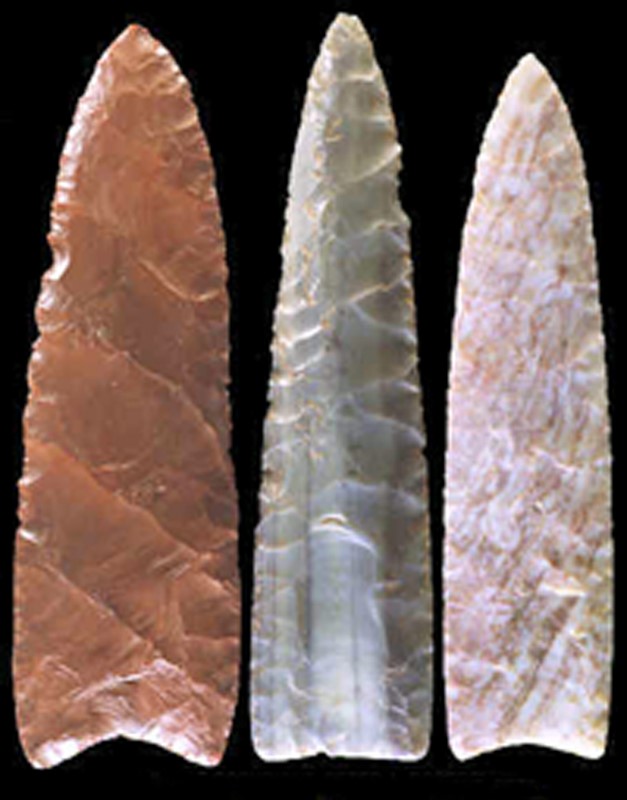
Sometime earlier, Dennis Stanford and Bruce Bradley had realised it was necessary to find artefacts in the Americas to bridge the gap in chronology between the Solutrean and Clovis cultures. So they scoured Clovis’s sites across the continent, places where other archaeologists had been digging for years. Their first success came from Clovis technology, a site called Cactus Hill, in Virginia, a point that resembled the Solutrean style—and it dated far earlier than the Clovis points. (Stanford & Bradley, 2004)
During the PBS interview, Dr Stanford stated:
“Here we have a projectile point from a feature that dates right at 15,900 years or 16,000 years ago, which is clearly right in the middle between Clovis and Solutrean. And what’s really exciting about it is that the technology here is very similar to Solutrean. In fact, it’s closer to Solutrean than Clovis where you can see that it’s in a progression between Solutrean and Clovis, so you have Solutrean, Cactus Hill and Clovis.”
According to an interview by A. J. Hostetler, Newspaper Journalist (published in the Richmond Times-Dispatch, May 11, 2006), Stanford stated that his “testable model” rested at least in part on recent findings of early human settlements along the East Coast, including one possibly 17,000 years old along Virginia’s Nottoway River called Cactus Hill.
Dr Eske Willerslev, director of the Centre for GeoGenetics at the Natural History Museum of Denmark, University of Copenhagen, has reported to Science Daily (October 20 2011) that a pre-Clovis, manufactured spear point had been discovered by archaeologists 30 years ago embedded in the remains of a mastodon dating at least a thousand years before the arrival of the Clovis culture in North America. The original discovery took place at the Manis site in Washington’s state.
Professor Willerslev’s team, in collaboration with Michael Waters’ team at the Center for the Study of the First Americans, University of Texas A&M, has finally established a firm date of 13,800 BP for the kill by the convergence of no less than five different dating methods. (Waters, Stafford, et al., 2008) Included in Willerslev’s report was the following significant statement:
“Our research now shows that other hunters were present at least 1,000 years before the Clovis culture. Therefore, it was not a sudden war or a quick slaughtering of the mastodons by the Clovis culture, which made the species disappear. Instead, we can now conclude that the hunt for the animals stretched out over a much longer period of time. . . Maybe the reason was something completely different, for instance, the climate.”
The Gault Site, located in central Texas about 40 miles north of Austin, is considered one of the premier archaeological discoveries in North America. James E. Pearce, known as the Father of Texas archaeology, excavated the site in 1929. It has more recently been excavated by Michael B. Collins and Thomas R. Hester of the Texas Archaeological Research Laboratory at the University of Texas at Austin.
The Gault materials tend to push ‘Clovis’ back at least another 1000 years—back to 13,500 BP and beyond—and so far represents 65% of all known ‘Clovis’ artefacts. (Collins & Hester, 2001) Recent excavations have brought to light incised stones, a true rarity in North America. Some archaeologists see a ‘link’ with the Upper Paleolithic cultures of Europe (Collins, n.d.; Wisner, 2000, et al.).
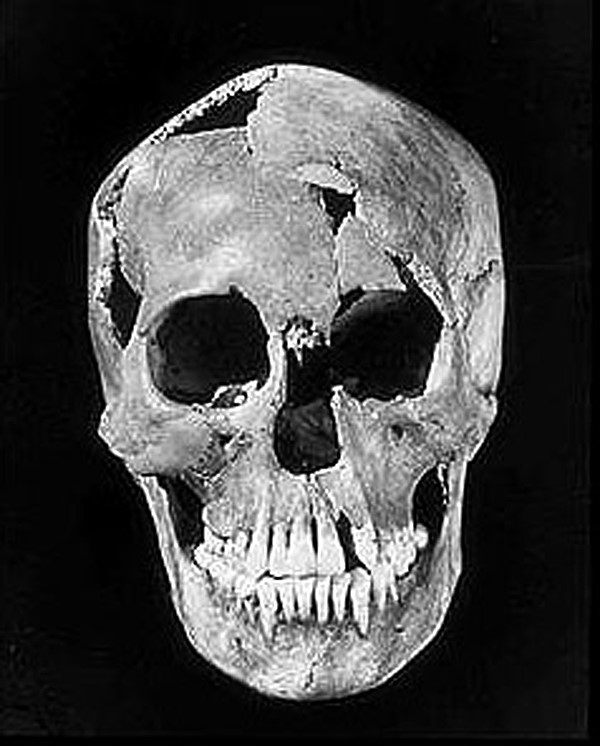
Sandia Cave (Hibben, 1941), The Lewisville site (Krieger, 1957), The Gault site (Collins & Hester, 2001), Meadowcroft Rockshelter (Adovasio, et al., 1990), Cactus Hill (Dillehay, 1989), Monte Verde (Adovasio & Pedler, 1997), Pedra Furada (Collins, 1999), the Manis site (1978), and numerous other more recent archaeological discoveries, are beginning to fi ll in the chronological ‘void’ between the time of the Solutreans in Europe and Clovis in America, leaving little doubt that human populations have been living in the Americas for at least 40,000 years. (Dillehay, 1999, et al.)
The skull of the 15-year-old girl known as Minnesota Woman. Her remains were found beneath the layers laid down much later in the area by glacial Lake Pelican in Minnesota, which had formed near the end of the ice age. (Blegen, 1975) Noticed the ‘European-like’ features of this specimen. She has been tentatively dated at 7890 BP. Another similar find has been christened Eva de Naharon, a 13,600-year-old skeleton found in an underwater cave near Tulum, Mexico.
The skull of another young woman, nicknamed Luzia, has been dated 11,500 years ago. After two decades in storage at the National Museum in Brazil, Brazilian scientists identified the fossilised cranium to be “the oldest human remains ever recovered in the Western Hemisphere.” It is now only one of several such as fossils. When first unearthed, the skull was separated from the skeleton but was in good condition. Surprisingly, this particular fossil exhibited Negoid characteristics (Williams, 2003).
British scientists have analysed an American skeleton of a 26-year-old woman who died during the last ice age on the edge of prehistoric Lake Texcoco, which once existed in the Valley of Mexico. The remains were dated at ca. 13,000 BP by Liverpool’s John Moores University and Oxford’s Research Laboratory of Archaeology. She has been christened Peñon Woman by her discoverers.
The most intriguing aspect of the skull is that it is very European in appearance (Conner, 2002). Upon examining the bones, Dr. Silvia Gonzalez, an archaeologist working at John Moores University and the leader of the research team, found the skull to be ‘dolichocephalic’; that is, long and narrow, like those of western Europeans of today, not short and wide like the Mongols of Asia. However, the origin of the people represented here remains in debate.
So do these findings correlate?
Cro-Magnon’s tools are described as the Aurignacian technology, characterised by bone and antler tools, such as spear tips (the first) and harpoons. They also used animal traps and bow and arrows. In addition, they invented shafts and handles for their knives, securing their blades with bitumen, a kind of tar, as long as 40 thousand years ago. Other improvements included the invention of the atlatl, a large bone or piece of wood with a hooked groove used for adding distance and speed to spears.
They also invented more sophisticated spear points, such as detach after striking and cause more significant damage to prey. The Cro-Magnon type man was also the ‘originator’ of such abstract concepts as ‘time.’ They marked time by lunar phases, recording them with marks on a piece of bone, antler or stone. Some of these ‘calendars’ contained a record of as many as 24 lunations.
In the relatively recent past, tool industries diversified.
The Gravettian industry (25 to 15 thousand years ago), characterised by ivory tools such as backed blades, is associated with mammoth hunters. One type of brief industry was Solutrean, occurring from 18 to 15 thousand years ago and limited to Southwest France and Spain. It is characterised by unique and finely crafted ‘laurel leaf’ blades, made with a pressure technique requiring great skill.
The industry is associated with horse hunters. The tool industry of the Clovis Culture in North America (11 to 8 thousand years ago) is notable for its remarkable similarity to Solutrean. Some suggest that the Solutrean culture migrated to North America around 12,000 thousand years ago.
Cro-Magnon people lived in tents and boats in groups of several families. They were nomadic hunter-gatherers and fishermen with elaborate rituals for hunting, birth and death. As a result, multiple burials are common in the areas where they were found. Interestingly, from 35 to 10 thousand years ago, there was no differentiation by sex or age in burials.
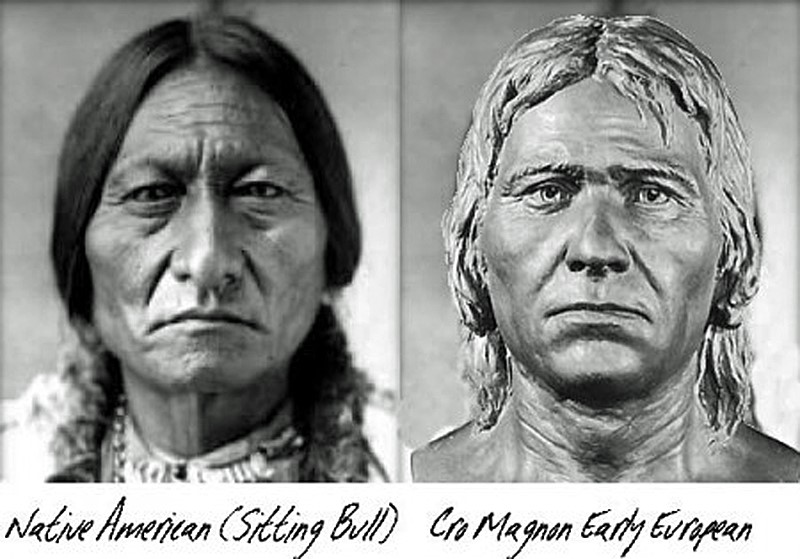
In contrast to everyday, utilitarian objects, they included unique grave goods, suggesting an immensely increased ritualisation of death and burial. They were also the first confirmed to have domesticated animals, starting about 15 thousand years ago.
They were the first to leave extensive works of art, such as cave paintings and carved figures of animals and pregnant women. Huge caves lavishly decorated with murals depicting animals were at first rejected as fake for being too sophisticated. Then they were dismissed as being primitive, categorised as hunting, fertility or other types of sympathetic magic.
Re-evaluations have put these incredible works of art in a more prominent place in art history – as suggested by Picasso, who declared on seeing the paintings, “We have invented nothing !!”
They show evidence of motifs, of following their stylistic tradition, of ‘impressionist’ like style, perspective, and innovative use of the natural relief in the caves. Also possible, considering the new concepts of time reckoning practised by Cro-Magnon, are abstract representations of the passage of time, such as spring plants in bloom or pregnant bison that might represent summer.
Aside from pregnant women and other Goddess worship iconography, representations of people, ‘anthropomorphs,’ are very few and never show the accuracy or detail of the other animals. Humans are represented in simple outlines without features, sometimes with ‘masks,’ often without regard to proportion, being distorted and isolated. At the Grottes des Enfants in France are found four burials with red ocher and associated with Aurignacian tools.
At Lascaux, France, are the famous caves of upper Paleolithic cave art, dated to 17 thousand years ago, and even older, in some cases, by many thousands of years!
The modern human types that appeared in the Levant were, however, somewhat different from Cro-Magnon. They were the sub-Saharan type, less ‘robust’ individuals than the Cro-Magnon ‘homo superior’ of Europe.
But then, how to explain what happened in any reasonable terms?
What the archaeological record seems to show is that in Europe, after millennia of almost no progress at all, even in the few areas where modern man has been found, suddenly human culture seems to take off like an explosion with the appearance of Cro-Magnon man.
Not only does culture explode, but also new ways of doing things, new styles and innovations that were utterly unknown in the period immediately preceding them, suddenly appear, only to disappear again like an outdated fad. From Spain to the Urals, sites list the developments of sewing needles, barbed projectiles, fishhooks, ropes, meat drying racks, temperature-controlled hearths, and complex dwellings.
The most amazing part of all of it is the art. Art suddenly springs onto the landscape, fully formed, with no period of gradual development; no signs of childish attempts preceding it. A piece of ivory carved 32,000 years ago is as realistic as anything turned out by the most accomplished carver of the present day.
The Upper Palaeolithic signals the most fundamental change in human behaviour that the archaeological record may ever reveal. The only explanation for this tremendous change is that a new kind of human appeared on the Earth’s stage. When we consider the difficulties of such an event, we find that this presents a huge difficulty in our understanding in terms of’ evolution.
First of all, we still have the problem of a 60,000-year time lag between the appearance of the sub-Saharan modern type man who was on the scene with no ‘improvements’ in his technology for that length of time.
If Cro-Magnon evolved in Africa, why isn’t there a continuous record of incremental developments? By the same reasoning, if he developed only after crossing the Mediterranean to Europe, why isn’t there a constant record of incremental developments?
The most effective and popular way that science deals with this crisis is to ignore it, deny it, or seek to twist the facts to fit the theory. Many archaeologists continue to account for the cultural events of the Upper Paleolithic by tying them to the emergence of a more modern, intellectually superior form of a human being from Africa. They propose a ‘second biological event’ to explain this, never mind that it left no tracks in any skeletal shape.
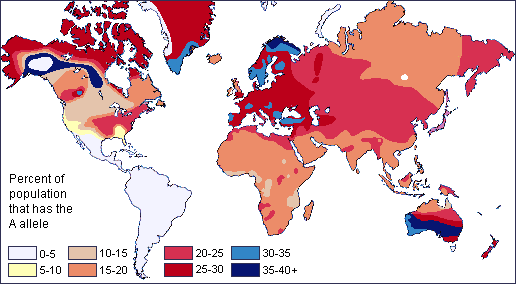
Nowadays, the idea suggests that the other ‘modern men’ of sub-Saharan Africa were not really thoroughly modern. On the contrary, they were ‘near-modern’. Thus, Africa is preserved as the origin of all humanity, and the only thing necessary was a breakthrough in the African lineage, a ‘neurological event’ that allowed this ‘new man’ to develop all these new cultural behaviours overnight, so to say. This amounts to saying that the explosion of culture in the Upper Paleolithic times did not happen earlier because other modern men didn’t have the brains to make it happen.
Unfortunately, the support for this idea amounts only to circular logic. What’s more, it seems that it would start in a small place and spread outward if it were a neurological event. We ought to note that the Neanderthals did not have art. What’s more, there was essentially no change in their stone tools for 100,000 years.
Some people suggest that the impetus for culture was the sudden development of speech. But that idea doesn’t hold much water either. If we were to look at some of the aboriginal societies of Australia and New Guinea, they are undoubtedly Neanderthal-like in their stone tools. However, they think and communicate in languages that are as rich as ours, and they construct myths, stories and cosmologies with these languages. They just don’t seem to be much interested in technology.
We have already noted the pottery making of the Jomon. Even more startling is the fact that twenty-six thousand years ago, the residents of Dolni Vestonice were firing ceramics in kilns. However, you don’t read that in archaeology textbooks. In the standard teachings, the emergence of ceramics is linked to the functional use of pottery, which supposedly did not appear until the agricultural revolution in the Neolithic period, some 12,000 years after the kilns at Dolni were last used.
This brings us to another curious thing about Neanderthal man: he never seemed to go anywhere. He always made his tools out of what was locally available, and he never seemed to travel at all. What was made where it was made stayed there. Nobody traded or shared among the Neanderthal groups.
But it seems that right from the beginning, Cro-Magnon man was travelling and sharing and exchanging goods and technology. This degree of travelling could only have been achieved by boats and ships. If there was a better form of stone somewhere else, the word seemed to get around, and everybody had some of it.
Distinctive flints from southern Poland are found at Dolni Vestonice, a hundred miles to the south. Slovakian radiolarite of red, yellow and olive is found a hundred miles to the east. Later in the Upper Paleolithic period, the famous ‘chocolate flint’ of southern Poland is located over a radius of two hundred and fifty miles.
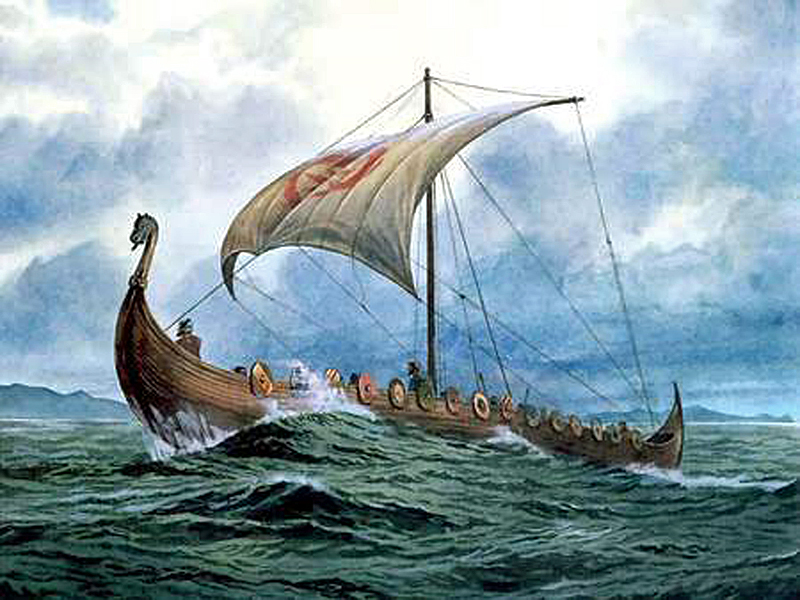
Naturally, these rocks didn’t walk around on their own. Human legs carried them. And that leads us to our next little problem with Cro-Magnon man: You see, his legs were too long.
One of the sacred laws of evolutionary biology is called ‘Allen’s Rule.’
This rule posits that legs, arms, ears, and other body extremities should be shorter in mammals that live in cold climates and longer in mammals of the same period who live where it is hot. This is because having short arms and legs conserves heat. This is supposed to explain why Eskimos and Laplanders have short legs. It also is supposed to explain why Bantu people are leaner, and the Maasai is exceptionally long and thin in their tropical open country.
The only people who seem to be mocking Allen’s rule are the Cro-Magnons. They just refused to adapt or did they travel so widely the rule did not affect them like us today? They all have much longer legs than they ought to. Of course, this is pounced upon as proof that they came from Africa. The only problem with this is that it is hard to imagine people from a warm climate migrating to a cold one by choice.
Then, on top of that, to remain long-limbed for over a thousand generations? Keep in mind that, during that time, the thermometer kept going down and, at the glacial maximum, 18,000 years ago, it was like the North Pole in northern Europe!
By whatever means they arrived in Europe, we ought to note that their presence may be related to the fact that Europe and other nearby locations are blanketed with megaliths. Indeed, it may be so that the megaliths came long after the appearance of Cro-Magnon man, but the connection ought not to be discarded without some consideration.
We have still another problem here, and it has to do with dating. Analysing mitochondrial DNA data to reconstruct the demographic prehistory of Homo Sapiens reveals statistical evidence of explosive growth around 50,000 years ago.
Is there a connection between this DNA evidence and the appearance of Cro-Magnon man?
If so, it would mean that the DNA is dated to twice the age that archaeology confirms. Instead of assuming that the archaeological dates are correct, perhaps we ought to ask whether something could be wrong with the dating? From a morphological point of view and judging by their industry and art, these highly evolved humans that coexisted with Neanderthal man represent a mutation so enormous and sudden as to be absurd in the context of evolutionary theory.
CONCLUSION
The above admission opens up several other problems. Archaeology is beginning to demonstrate clearly that ice-age humanity was getting to the shores of the Americas. However, to cross a 3,000 mile-Wide Ocean requires some technology and logistics that are not being faced. It takes months to travel a body of water as large as the Atlantic, which necessitates food, water and other supplies, which in turn require a sufficient amount of onboard storage space. Therefore, we are not talking about small flimsy boats made of animal skins and a crew of two. A crew of at least a dozen is far more likely.
We are, therefore, postulating a ship at least as large as the average Viking vessel or possibly as large as ancient Phoenician warships. Such would need to be propelled by sails or other means, which would necessitate a sizeable crew. Navigational knowledge and techniques (with the necessary instrumentation) must be assumed. The alternative to this is to admit a reasonably large landmass (and maybe some islands) in the mid-Atlantic during the ice age to shorten the trip.
And we shouldn’t forget the archaeological and anthropological evidence that several ice age ‘invasions’ of Western Europe and Northwest Africa originated from some unknown location to the West of those landmasses (i.e., in the North Atlantic Ocean) during this same time frame. Thus, it seems more reasonable to postulate the presence of a mid-Atlantic mainland with shorter ocean voyages to the east and the West than to theorise about long ocean voyages from starting points on the opposite side of the globe, when the origin of these well-documented Upper Palaeolithic cultures points to such a source.
The fact that Blood was once ALL ‘O’ RH positive, as shown in the existing indigenous tribes of South America, Africa and Australia, shows us that the fact we have AB blood types proves beyond any doubt that the human species ‘mutated’ at some point in its journey ‘Out of Africa’.
Darwin’s observations of nature and its species show us that this ‘mutation’ is commonplace in history and, therefore, should be no surprise to anthropologists. Blood cannot mutate naturally in homo sapiens; the result of this genetically modified mutation has to be a new form of ‘Homo Sapien’.
Fifty thousand years ago, Homo Sapiens moved out of Africa to the Caspian Sea – the Haplogroups DNA record bear testament to this fact, as it too mutated into two new Haplogroups (A, B and G); this was at the point of ‘first contact’ with the Homo Sapiens cousins the Homo Neanderthal. It was also at this point that the blood groups AB were established. This ‘mutation’ is now accepted as 3% of most Homo Sapiens contain Neanderthal DNA showing cross breading, and it was also at this point of history that ‘Cro-Magnon’s’ evolved.
This species of mankind had superior powers (Homo Superior?) to Neanderthal and Homo Sapien Cousins. This was proved during the last Ice Age where the Cro-Magnon survived and took the green pastures of their ‘brave new world’ at the expense of the Neanderthals that were doomed to extinction – proving once again Darwin’s ‘survival of the fittest’ on planet earth.
For more information about Cro_magnon’s visit our website or our Video Channel.
Further Reading
For information about British Prehistory, visit www.prehistoric-britain.co.uk for the most extensive archaeology blogs and investigations collection, including modern LiDAR reports. This site also includes extracts and articles from the Robert John Langdon Trilogy about Britain in the Prehistoric period, including titles such as The Stonehenge Enigma, Dawn of the Lost Civilisation and the ultimate proof of Post Glacial Flooding and the landscape we see today.
Robert John Langdon has also created a YouTube web channel with over 100 investigations and video documentaries to support his classic trilogy (Prehistoric Britain). He has also released a collection of strange coincidences that he calls ‘13 Things that Don’t Make Sense in History’ and his recent discovery of a lost Stone Avenue at Avebury in Wiltshire called ‘Silbury Avenue – the Lost Stone Avenue’.
Langdon has also produced a series of ‘shorts’, which are extracts from his main body of books:
For active discussions on the findings of the TRILOGY and recent LiDAR investigations that are published on our WEBSITE, you can join our and leave a message or join the debate on our Facebook Group

